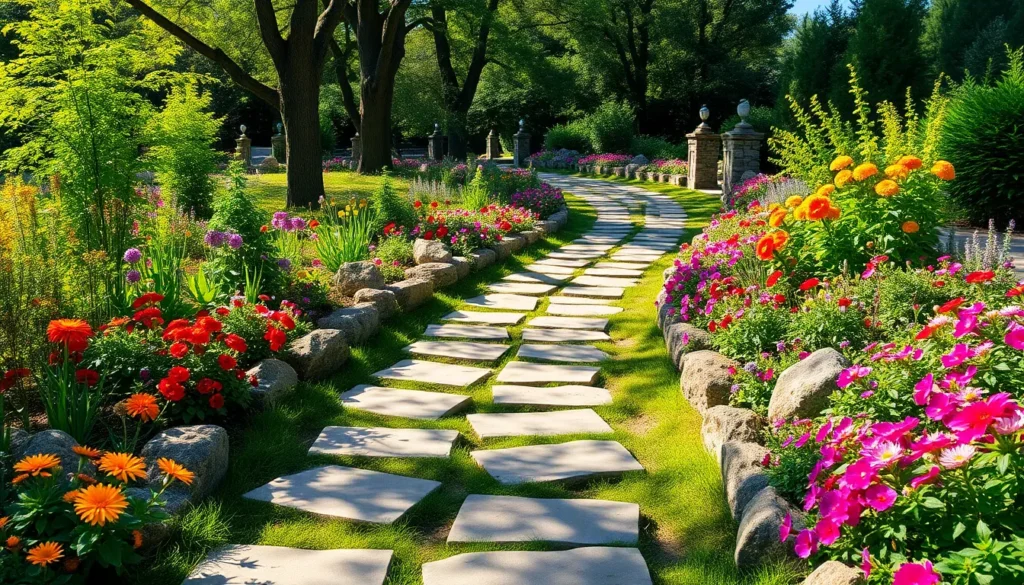We all know that first impressions matter – and your garden walkway sets the tone for your entire outdoor space. Whether you’re welcoming guests to your front door or creating a peaceful path through your backyard oasis, the right walkway design can transform an ordinary garden into something truly spectacular.
From rustic stepping stones that blend seamlessly with nature to elegant brick patterns that add timeless charm, there’s a walkway solution for every style and budget. We’ve discovered that the perfect garden path isn’t just about getting from point A to point B – it’s about creating an experience that draws people deeper into your industry.
Ready to turn that worn dirt trail into a stunning focal point? We’ll walk you through creative ideas that’ll make your neighbors stop and stare, practical answers that stand the test of time, and budget-friendly options that deliver maximum impact without very costly.
Natural Stone Pathways for Timeless Garden Appeal
Natural stone transforms ordinary garden paths into enduring statements of elegance. These materials offer unmatched durability while creating visual interest that complements any industry design.
Flagstone Walkways for Rustic Charm
Flagstone creates the perfect foundation for gardens with a relaxed, countryside aesthetic. We recommend choosing sandstone or limestone varieties for their natural color variations and weather resistance. Installing flagstone requires proper base preparation with 2-3 inches of crushed gravel and sand leveling.
Large irregular flagstone pieces work beautifully for primary walkways, while smaller uniform shapes suit secondary garden paths. Spacing between stones allows for moss growth or low groundcover plants like thyme and creeping phlox. This organic approach softens the hardscape and creates a lived-in appearance that develops character over time.
Budget considerations range from $8-15 per square foot for materials, making flagstone an accessible option for most garden projects. We suggest purchasing extra stones to account for breakage during installation and future repairs.
Slate Stepping Stones for Modern Elegance
Slate stepping stones deliver sophisticated appeal with their smooth surfaces and consistent gray tones. These dense stones resist weathering while providing excellent traction in wet conditions. We typically space slate stones 18-24 inches apart for comfortable walking stride.
Round or square slate pieces measuring 16-20 inches work best for adult pathways, while smaller 12-14 inch stones suit children’s garden areas. Installing slate requires minimal excavation since the stones sit level with surrounding soil or mulch. This flush installation creates clean lines that enhance contemporary garden designs.
Maintenance involves occasional power washing to remove algae buildup and preserve the stone’s natural luster. We recommend sealing slate annually in harsh climate zones to prevent surface deterioration from freeze-thaw cycles.
River Rock Borders for Drainage and Style
River rock borders combine practical drainage answers with attractive visual elements along stone pathways. These smooth stones channel water away from main walkway surfaces while adding textural contrast. We install river rock in 4-6 inch wide channels alongside flagstone or slate paths.
Selecting rocks between 1-3 inches in diameter provides optimal water flow without creating walking hazards. Mixed color palettes featuring gray, brown, and tan stones complement most natural stone pathways. Installing industry fabric beneath river rock prevents weed growth while maintaining proper drainage function.
Cost effectiveness makes river rock borders appealing for budget conscious gardeners at $3-6 per linear foot. We source materials locally when possible to reduce transportation costs and ensure color compatibility with regional stone selections.
Brick and Paver Garden Walkway Designs
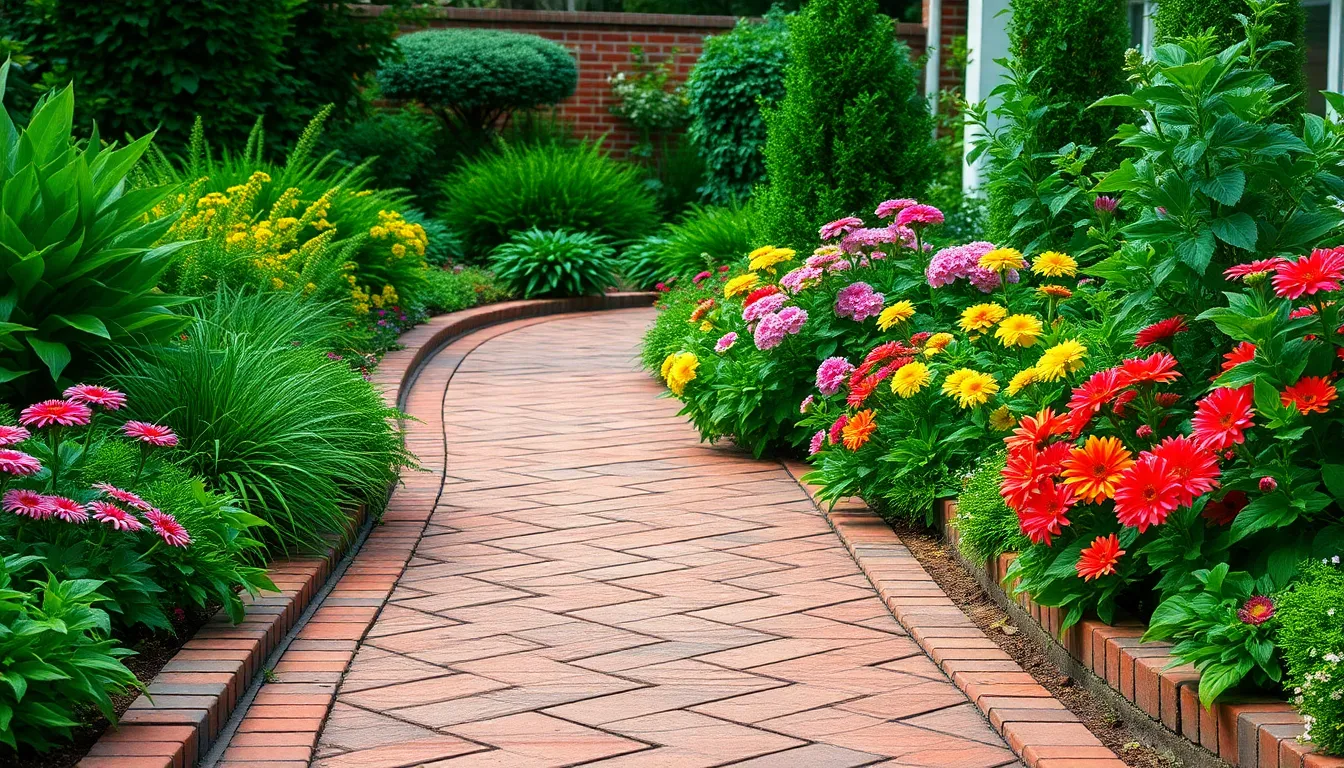
Brick and paver walkways combine durability with timeless aesthetic appeal, offering versatile design options that complement any garden style. These materials provide structural integrity while creating stunning visual focal points throughout your outdoor space.
Classic Red Brick Herringbone Patterns
Herringbone patterns create visual drama through their distinctive zigzag design, formed by laying bricks at 45-degree angles to each other. This traditional technique delivers both beauty and strength since the interlocking nature provides exceptional structural stability for high-traffic areas.
Red bricks offer warmth and versatility that works seamlessly with formal gardens, cottage landscapes, and everything in between. The classic color complements green foliage beautifully while maintaining its appeal through changing seasons and weather conditions.
Installation requires precise measurement to ensure proper angles and consistent spacing between each brick. We recommend using a string line and level to maintain straight edges, while a rubber mallet helps achieve tight fits without damaging the brick surfaces.
Interlocking Concrete Pavers for Durability
Interlocking concrete pavers feature notched edges that fit together snugly, creating a seamless surface that resists shifting and eliminates unsightly gaps over time. Their engineered design makes them ideal for garden pathways that experience heavy foot traffic.
Durability stands as their primary advantage, with superior resistance to weathering, cracking, and fading compared to traditional concrete slabs. These pavers maintain their appearance and structural integrity through freeze-thaw cycles and seasonal ground movement.
Color and finish options abound with manufacturers offering various shapes, textures, and hues to match your garden’s aesthetic. From smooth contemporary finishes to textured surfaces that mimic natural stone, these pavers adapt to any design vision.
Maintenance remains minimal since individual pavers can be replaced if damaged, unlike monolithic concrete surfaces that require extensive repairs. Simple cleaning with water and occasional sand joint refilling keeps these walkways looking pristine.
Permeable Paver Options for Eco-Friendly Gardens
Permeable pavers allow water drainage through their surface structure, reducing runoff while promoting groundwater recharge in your garden network. These environmentally conscious options feature open spaces or gaps filled with gravel or grass.
Environmental benefits include minimized water runoff that can cause erosion and flooding, while supporting soil health through natural water filtration. This sustainable approach proves especially valuable in regions experiencing heavy rainfall patterns.
Installation involves strategic spacing with permeable materials like gravel or specialized grass varieties filling the gaps between pavers. This design creates a functional walking surface while maintaining the ecological benefits of water absorption.
Eco-conscious gardeners appreciate how these systems reduce their environmental footprint while creating attractive pathways. The combination of functionality and sustainability makes permeable pavers an excellent choice for modern industry design.
Gravel and Mulch Walkway Solutions
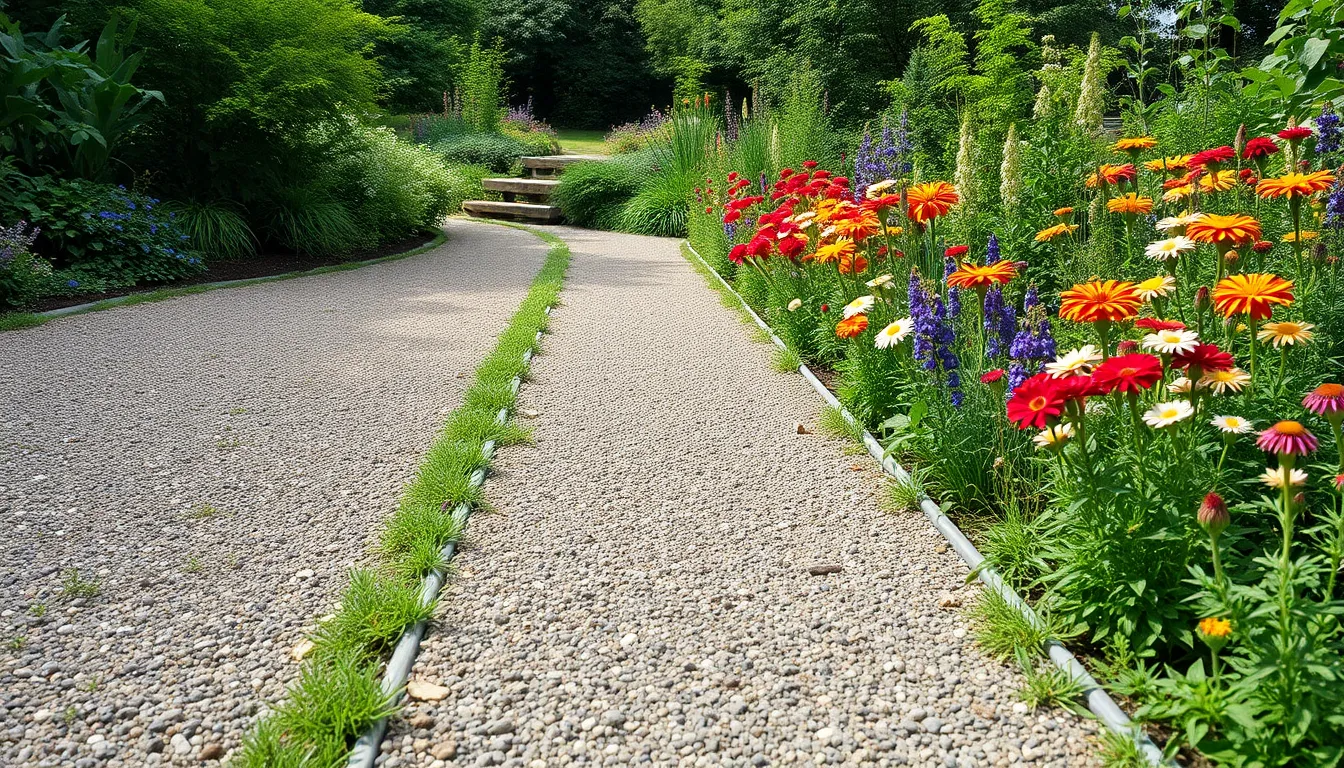
Affordable and naturally beautiful, gravel and mulch pathways offer excellent drainage while maintaining a rustic garden aesthetic. These materials eliminate muddy paths and create permeable surfaces that complement any industry design.
Decomposed Granite for Low-Maintenance Paths
Decomposed granite provides a cost-effective solution that compacts into a stable, firm surface for high-traffic garden areas. We recommend using a tamper or roller to achieve proper compaction, creating a permeable yet durable walkway that blends seamlessly into natural landscapes.
Installation requires minimal preparation since decomposed granite naturally settles and hardens over time. The material’s neutral color palette works well with various garden styles, from contemporary to traditional designs.
Maintenance demands are exceptionally low compared to other pathway materials. We find that occasional raking and top-dressing every few years keeps these paths looking fresh and functional.
Wood Chip Mulch Walkways for Natural Gardens
Wood chip pathways excel in woodland and natural garden settings where organic materials enhance the overall aesthetic. We simply rake wood chips onto cleared paths, creating an immediately usable surface that insulates soil and reduces weed growth.
Environmental benefits include soil enrichment as the chips decompose naturally over time. These pathways are highly sustainable and require periodic replenishment rather than complete replacement.
Installation involves clearing the desired path area and spreading wood chips to a depth of 2-3 inches. We recommend using bark or hardwood chips for longer-lasting results in high-traffic areas.
Pea Gravel Paths with Steel Edging
Pea gravel creates smooth, attractive walkways available in various colors and sizes to match any garden design. We use steel or metal edging to maintain clean borders and prevent gravel from spreading into surrounding planting areas.
Safety features include rounded stones that reduce injury risk compared to angular gravel options. The smooth surface provides comfortable walking while maintaining excellent drainage properties.
Design flexibility allows us to create both formal and informal pathway styles using different pea gravel colors and edging materials. Steel edging ensures long-term durability and simplifies ongoing maintenance tasks.
Creative DIY Garden Walkway Ideas

DIY garden walkways offer endless possibilities for personal expression while creating functional pathways that reflect your unique style. These creative approaches let you customize your outdoor space with handcrafted elements that stand out from traditional materials.
Mosaic Tile Stepping Stones
Mosaic tile stepping stones transform ordinary pathways into artistic masterpieces that showcase your creativity. We recommend using a concrete base to ensure durability and longevity for these colorful installations. The process involves creating individual stepping stones with broken tiles, glass pieces, or ceramic fragments arranged in patterns that complement your garden’s aesthetic.
Each stone becomes a canvas where you can experiment with different color combinations and geometric designs. Start by mixing concrete and pouring it into circular molds, then press your mosaic pieces into the surface before it fully sets. Allow for personalization by incorporating meaningful objects like shells, buttons, or decorative stones that tell your garden’s story.
Weather resistance improves when you seal the finished stones with appropriate concrete sealers. These artistic elements require minimal maintenance once properly installed and can withstand foot traffic for years. The unique visual appeal of mosaic stepping stones creates conversation pieces that guests will remember long after their visit.
Reclaimed Wood Plank Pathways
Reclaimed wood plank pathways bring rustic charm to your garden while promoting environmental sustainability. We love how these pathways add natural aesthetic appeal that complements both cottage and modern garden designs. Old barn wood, weathered deck boards, or salvaged lumber from construction projects work perfectly for this application.
Installation requires proper ground preparation to prevent rot and ensure stability over time. Lay industry fabric beneath the planks to suppress weeds and improve drainage around the wood surface. Space the planks slightly apart to allow for natural expansion and contraction with seasonal temperature changes.
Choose hardwood varieties like oak or cedar when possible, as they resist decay better than softwood options. Apply wood preservative treatments annually to extend the lifespan of your reclaimed wood pathway. The weathered appearance develops character over time, creating an increasingly attractive patina that enhances your garden’s natural beauty.
Concrete Mold Walkways with Custom Designs
Concrete mold walkways offer unlimited design possibilities for creating custom pathways that perfectly match your vision. We recommend using boulder shaped molds to achieve a natural stone appearance without the expensive cost of actual stone materials. This technique allows for wide range of patterns and shapes that can mimic expensive materials at a fraction of the cost.
Pour standard concrete mix into your chosen molds, adding colorants or texture additives to enhance the final appearance. Release agents prevent the concrete from sticking to the molds and ensure clean removal once cured. Multiple molds let you create consistent shapes quickly, building your pathway section by section.
Custom designs can incorporate family handprints, decorative stamps, or embedded objects that make each section unique. The concrete surface accepts stains and paints, allowing you to adjust colors after installation if needed. These durable walkways handle heavy foot traffic and weather extremes while maintaining their appearance for decades with minimal maintenance.
Curved and Winding Garden Path Layouts

Curved and winding pathways transform your garden into an inviting space that naturally encourages exploration. These ever-changing layouts make your outdoor space feel larger while creating an element of mystery about what lies around each bend.
Meandering Paths Through Flower Beds
Meandering paths that wind through flower beds offer the perfect balance of functionality and beauty. These gently curving walkways encourage visitors to slow down and truly appreciate the surrounding plantings as they move through your garden space.
Stepping stones work exceptionally well for these informal paths, allowing you to create narrow walkways that integrate seamlessly with your planting schemes. Mulch provides another excellent material choice, maintaining that garden-like atmosphere while offering practical benefits for the surrounding plants. Crushed gravel delivers durability and drainage while preserving the informal aesthetic that makes meandering paths so appealing.
We recommend designing these paths to showcase seasonal blooms throughout the year. Spring bulbs can line the edges in early months, while summer perennials create colorful displays during peak growing season. Fall foliage and winter interest plants ensure your meandering walkway remains attractive across all seasons.
S-Curved Walkways for Visual Interest
S-curved walkways feature gentle, alternating curves that create the distinctive “S” shape, adding sophisticated movement to your garden design. These layouts work particularly well in larger landscapes where you want to guide visitors toward exact focal points while maintaining natural flow.
Flagstone creates an elegant foundation for S-curved paths, with its irregular shapes complementing the organic curves beautifully. Decomposed granite compacts into a stable walking surface that follows curves smoothly while requiring minimal maintenance over time. Gravel options provide excellent drainage and can be easily shaped to accommodate the flowing lines of your S-curved design.
Visual interest increases dramatically when you vary the width of your S-curved pathway at different points. Wider sections can accommodate small seating areas or display spaces for garden art, while narrower portions create intimate passages between planted areas.
Spiral Garden Paths Around Central Features
Spiral paths wrap around central features like mature trees, sculptural elements, or water fountains, creating striking visual effects that draw attention to your garden’s focal points. This layout works exceptionally well in smaller spaces or circular garden beds where you want maximum impact.
Materials that contrast with surrounding plants or lawn areas help highlight the spiral shape and enhance your garden’s overall structure. Light-colored gravel creates beautiful contrast against dark mulched beds, while brick or stone provides formal elegance around sophisticated central features.
We’ve found that spiral walkways work best when the central feature has year-round appeal. Evergreen trees provide consistent structure, while sculptural elements create artistic focal points that remain interesting through all seasons. Water features add the bonus of sound and movement, making your spiral path even more captivating for visitors exploring your garden space.
Lighted Walkway Ideas for Evening Garden Enjoyment
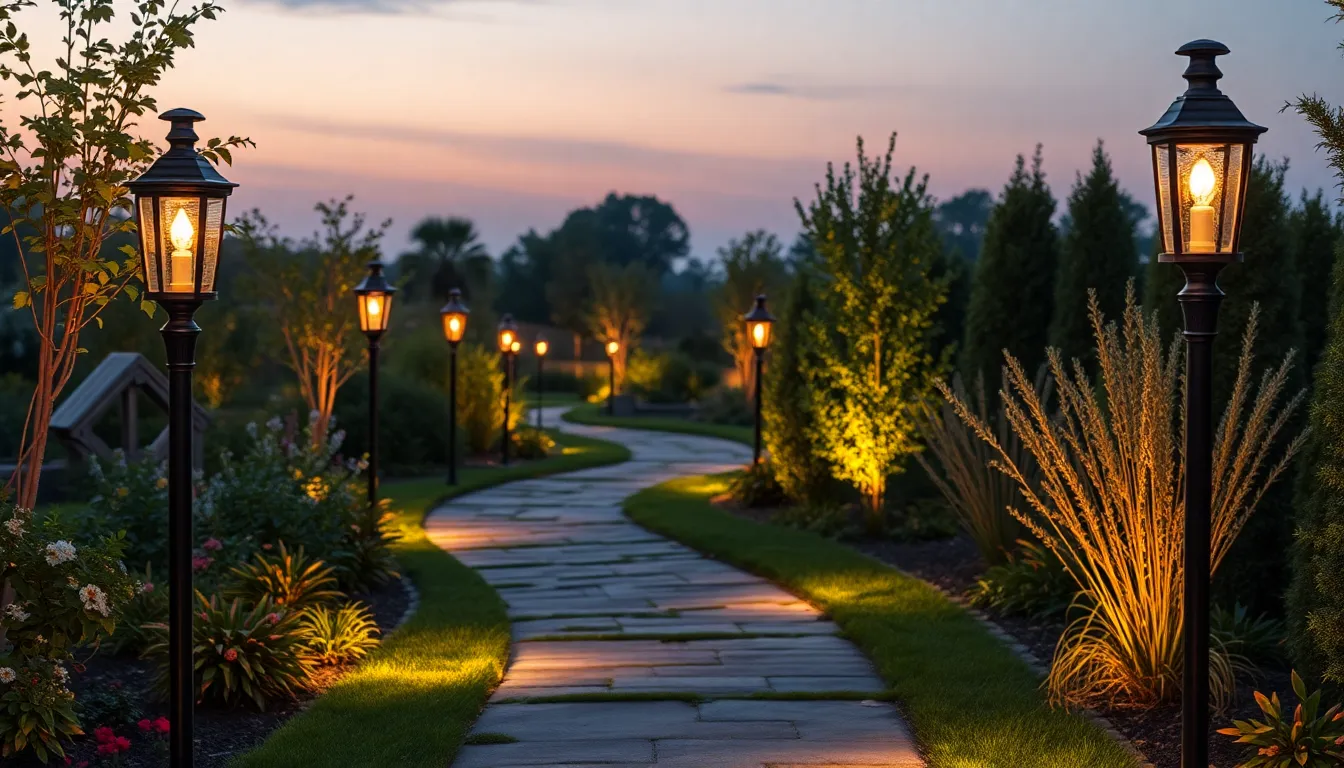
Transform your garden walkways into magical evening destinations with strategic lighting that ensures both safety and enchanting ambiance. Properly illuminated paths extend the usable hours of your outdoor space while creating stunning visual appeal after dark.
Solar-Powered Path Lighting Options
Solar-powered pathway lights deliver energy-efficient illumination without requiring electrical connections or ongoing electricity costs. Beau Jardin Solar Pathway Light stands out with its classic design and highly rated efficiency, making it a top choice for traditional garden styles. Modern aesthetics shine with Bobcat Solar Pathway Lights, which feature sleeker profiles that complement contemporary industry designs.
Installing solar pathway lights eliminates the complexity of running electrical lines through your garden beds. These fixtures automatically charge during daylight hours and provide consistent evening illumination for 8-12 hours. Weather-resistant construction ensures reliable performance through seasons, while adjustable brightness settings allow customization based on your exact lighting needs.
Position solar lights every 6-8 feet along pathway edges for optimal coverage and safety. Battery life typically lasts 2-3 years before replacement, making maintenance minimal and cost-effective long term.
LED Strip Lights Under Pathway Edges
LED strip lighting creates distinctive modern ambiance by casting gentle glows beneath pathway borders and raised edges. Weather-resistant LED strips withstand outdoor conditions while consuming minimal energy compared to traditional lighting options. Installation involves securing waterproof strips along the underside of raised pathway materials like concrete pavers or stone slabs.
Programmable LED systems offer color-changing capabilities, allowing seasonal adjustments from warm white for cozy evenings to cooler tones for contemporary appeal. Low-voltage operation ensures safety around moisture while providing years of maintenance-free service.
Strategic placement under pathway edges eliminates harsh shadows while creating floating pathway effects that appear almost magical in darkness. Connect strips to smart home systems for automatic scheduling and remote control convenience.
Lantern-Style Posts Along Garden Walks
Lantern-style posts add traditional elegance while providing substantial pathway illumination through decorative fixtures mounted on sturdy posts. These fixtures complement various garden themes, from rustic farmhouse aesthetics to formal Victorian designs. Solar-powered lantern posts offer installation flexibility without electrical requirements, while hardwired options provide consistent brightness levels.
Standard lantern post spacing ranges from 12-15 feet apart for adequate coverage along main garden walkways. Materials include weather-resistant aluminum, cast iron, and composite options that maintain appearance through harsh weather conditions.
Consider lantern heights between 24-36 inches for optimal light distribution without overwhelming smaller garden spaces. Traditional glass panels diffuse light evenly, while modern acrylic options resist breakage and provide similar lighting effects with enhanced durability.
Budget-Friendly Garden Walkway Projects
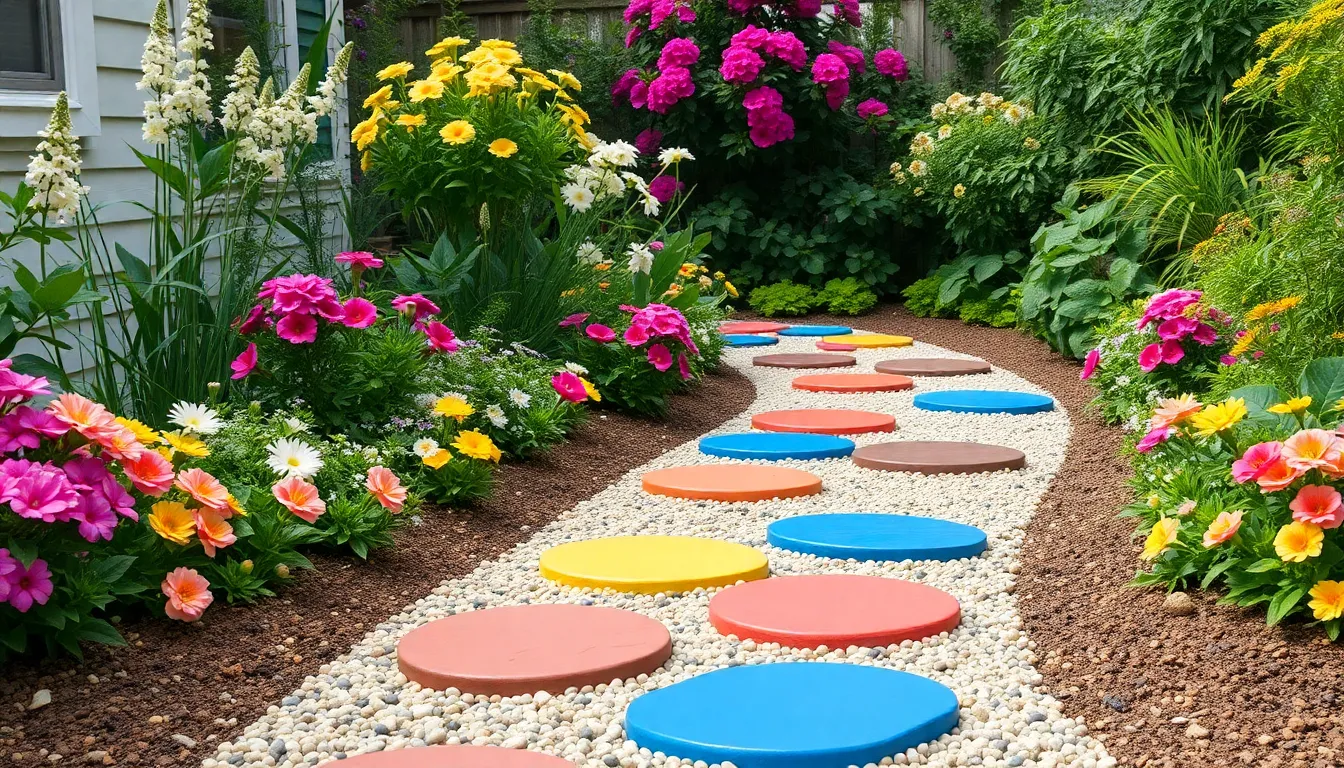
Creating stunning garden walkways doesn’t require very costly. We’ve discovered affordable answers that deliver professional results without the premium price tag.
Painted Concrete Stepping Stones
DIY concrete stepping stones offer unlimited customization potential at a fraction of natural stone costs. We mix standard concrete and pour it into simple molds, creating personalized pathway elements for under $3 per stone.
Vibrant paint colors transform plain concrete into eye-catching focal points after the concrete sets completely. Artists can create intricate patterns, nature motifs, or geometric designs that reflect their garden’s personality.
Cost effectiveness makes this approach particularly attractive since natural stepping stones typically cost $8 each or more. We save hundreds of dollars on larger walkway projects while maintaining complete creative control over the final appearance.
Recycled Material Pathway Ideas
Old bricks create charming pathways when sourced from demolition sites, neighborhood renovations, or your own garden projects. We’ve found that reclaimed bricks add authentic character while keeping material costs near zero.
Crushed stone pathways using recycled concrete or glass provide excellent drainage and visual interest. These materials cost significantly less than virgin stone while supporting environmental sustainability goals.
Wood pallet planks transform discarded shipping materials into rustic walkway sections. We cut pallets into uniform boards, treating them with weatherproofing stain to create durable pathway surfaces that complement natural garden settings.
Broken concrete pieces can be arranged into attractive stepping stone patterns when collected from sidewalk repairs or construction waste. This approach eliminates disposal fees while creating unique pathway textures.
Simple Sand and Stepping Stone Combinations
Sand fill answers between stepping stones create clean, maintenance friendly pathways that cost approximately $5 per bag. We use fine sand to eliminate weeds while providing stable footing between stone elements.
Gravel base preparation under stepping stones improves drainage and prevents shifting over time. This foundation method requires minimal investment but significantly extends pathway lifespan in high traffic areas.
Pea gravel combinations with stepping stones offer the most versatile design options at budget friendly prices. We spend about $5 per bag for pea gravel that complements stones costing $8 each, creating professional looking walkways for under $200 in most gardens.
| Material | Cost per Unit | Coverage Area | Installation Difficulty |
|---|---|---|---|
| Pea Gravel | $5 per bag | 50 sq ft | Easy |
| Sand Fill | $5 per bag | 75 sq ft | Easy |
| Stepping Stones | $8 each | 2 sq ft | Easy |
| Crushed Stone | $4 per bag | 60 sq ft | Easy |
Maintenance Tips for Long-Lasting Garden Walkways
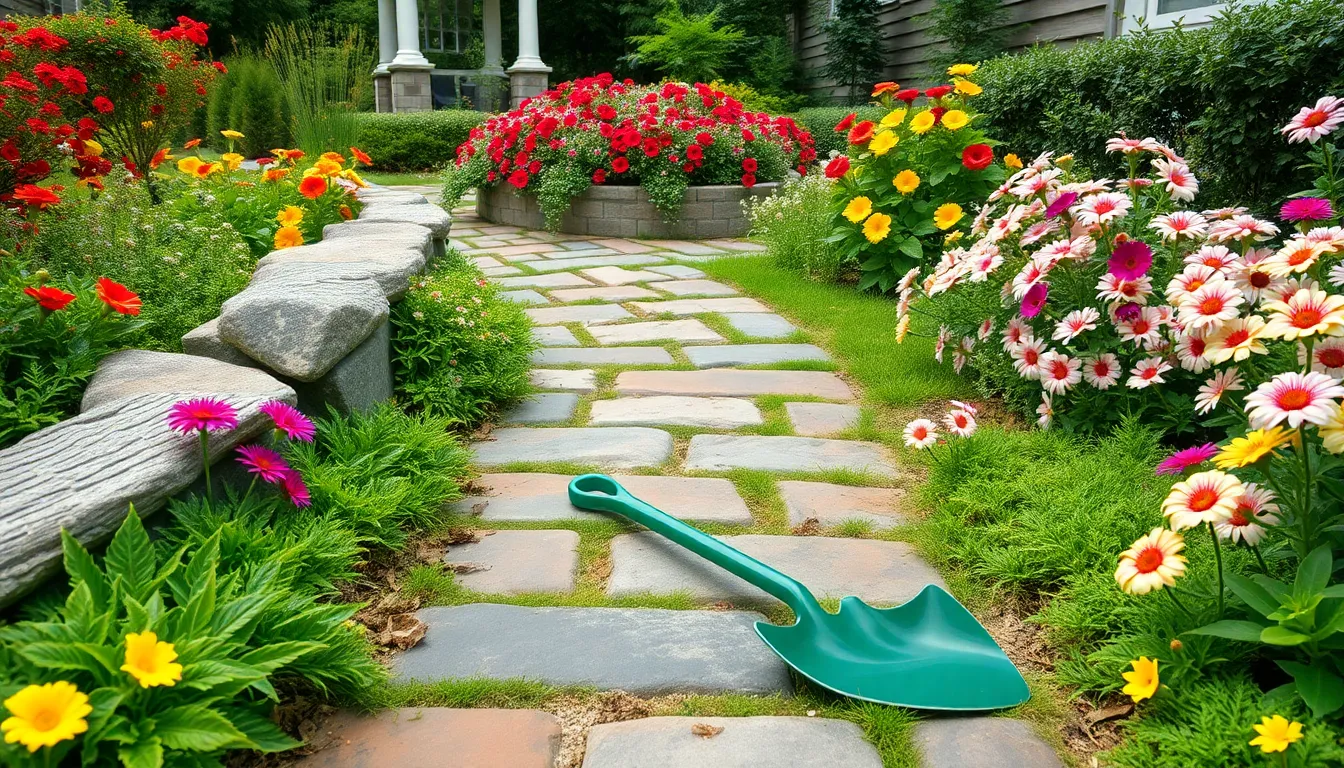
Protecting your garden walkway investment requires consistent care and attention throughout the year. We’ll share proven strategies that keep your pathways looking beautiful and functioning properly for decades to come.
Seasonal Cleaning and Upkeep
Spring maintenance sets the foundation for year-round walkway health by removing accumulated winter debris and assessing damage from freeze-thaw cycles. We recommend inspecting every surface for cracks, loose materials, or settling issues that winter weather may have caused. Clean thoroughly with mild detergent and water to remove salt residue, dirt, and organic matter that can stain or deteriorate pathway materials.
Summer upkeep focuses on regular debris removal to prevent staining and maintain safe walking surfaces. Sweep or blow leaves, twigs, and organic matter off walkways weekly to prevent moisture buildup underneath. Power washing monthly during peak growing season removes stubborn dirt and prevents algae growth on stone and concrete surfaces.
Autumn preparation involves clearing fallen leaves promptly and conducting thorough damage inspections before winter arrives. Remove all organic debris that could decompose and stain your walkway materials. Apply fresh sealant every 2-3 years during fall months when temperatures are moderate and humidity is low for optimal penetration.
Winter protection requires using appropriate ice melt products and avoiding metal shovels that can scratch or chip pathway surfaces. Choose calcium chloride or magnesium chloride instead of rock salt to minimize damage to stone and concrete. Use plastic shovels or rubber-edged tools when removing snow to preserve surface integrity.
Weed Prevention Strategies
Physical barriers create the most effective long-term weed control by preventing seeds from establishing in pathway joints and edges. Install galvanized steel, treated wood, or heavy-duty plastic edging materials along walkway borders to create clean separation between paths and surrounding garden beds. Maintain these barriers by checking annually for gaps or damage that weeds exploit.
Powered edging tools maintain precise boundaries between walkways and lawn areas while eliminating established weeds at their root systems. Use these tools monthly during growing season to cut clean lines that prevent grass and weeds from encroaching onto pathway surfaces. Sharp blades cut through root systems more effectively than dull ones, so replace or sharpen regularly.
Preventive treatments stop weed growth before it starts by applying suppressants or mulch to vulnerable areas around walkway edges. Spread industry fabric under gravel paths and apply pre-emergent herbicides in early spring before weed seeds germinate. Organic mulch options like shredded bark or wood chips provide natural weed suppression while improving your garden’s appearance.
Repair and Replacement Guidelines
Immediate intervention prevents small walkway issues from becoming expensive major repairs that require complete pathway reconstruction. Address loose pavers, small cracks, or minor settling within days of discovery to maintain structural integrity. Fill hairline cracks in concrete with appropriate sealers before water infiltration causes expansion and further damage.
Material-exact repair techniques ensure effective fixes that match your walkway’s original construction methods and materials. Stone pathways require different approaches than brick or concrete surfaces, with exact mortars, sands, or adhesives for each material type. Research manufacturer recommendations for your exact pathway materials before attempting repairs.
Strategic replacement decisions balance repair costs against long-term functionality when dealing with extensively damaged walkway sections. Replace individual pavers or stones when damage is localized, but consider complete section replacement when more than 30% of an area shows deterioration. Document repair dates and methods to track which techniques provide the longest-lasting results for future maintenance planning.
Conclusion
Creating the perfect garden walkway doesn’t have to be overwhelming or expensive. We’ve shown you countless options that can transform your outdoor space from basic stepping stones to elegant brick patterns and creative DIY answers.
The key is choosing materials and designs that match your garden’s style and your maintenance preferences. Whether you prefer the rustic charm of flagstone or the modern appeal of LED-lit concrete pavers your walkway should reflect your personal taste.
Remember that proper installation and regular maintenance will keep your garden path beautiful for years to come. With the right planning and these proven ideas you’ll create an inviting pathway that enhances your garden’s natural beauty while providing safe passage through your outdoor sanctuary.
Frequently Asked Questions
What are the most popular materials for garden walkways?
The most popular materials include natural stone (flagstone, slate, limestone), brick, concrete pavers, gravel, and wood chips. Natural stone offers timeless appeal and durability, while brick provides classic elegance. Gravel and mulch are budget-friendly options that provide excellent drainage and maintain a rustic aesthetic.
How much does it cost to install a flagstone walkway?
Flagstone walkways typically cost between $8-15 per square foot, depending on the stone quality and installation complexity. This includes materials and basic installation. Additional costs may apply for base preparation, edging, and professional installation services.
Are permeable pavers better for the environment?
Yes, permeable pavers are eco-friendly as they allow water to drain through the surface, reducing runoff and helping prevent flooding. They filter pollutants naturally and help recharge groundwater while maintaining the aesthetic appeal of traditional pavers.
What’s the easiest DIY walkway material to work with?
Pea gravel with steel edging is one of the easiest DIY options. It requires minimal preparation, provides excellent drainage, and costs only $3-6 per linear foot. Wood chip mulch is another beginner-friendly option that’s easy to install and maintain.
How do I maintain my garden walkway?
Regular maintenance includes seasonal cleaning, weed prevention, and prompt repairs. Spring inspections help identify winter damage, summer requires debris removal, autumn needs preparation for harsh weather, and winter protection prevents freeze damage. Address minor issues immediately to avoid costly repairs.
What lighting options work best for garden walkways?
Solar-powered pathway lights are energy-efficient and require no electrical connections. LED strip lights offer modern ambiance with programmable colors. Lantern-style posts provide traditional elegance and substantial illumination. Choose based on your garden style and lighting needs.
Can I create curved walkways in small gardens?
Yes, curved and winding paths work well in small spaces by creating visual interest and making gardens appear larger. S-curved walkways and meandering paths through flower beds maximize space while adding charm. Use materials like stepping stones or mulch for flexibility.
What’s the most budget-friendly walkway option?
Sand and stepping stone combinations are extremely budget-friendly and low-maintenance. DIY concrete stepping stones allow unlimited customization at low cost. Recycled materials like old bricks and pea gravel also offer affordable solutions starting around $3-6 per linear foot.

